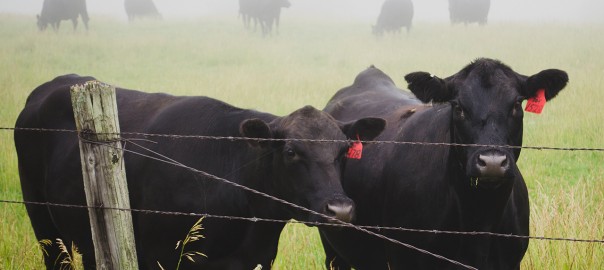We talk a lot about industry naming and labeling, and for a good reason: There are many confusing beef cut names, quality grades, and beef industry marketing tricks. Consumers are likely to have no idea that there are differences between USDA prime beef, organic steak, and grass-fed, grass-finished meat.
One brand name that has been used by the beef industry, steak restaurants, and fast food joints alike is “Angus.”
Angus beef is often used to designate a better quality product. But in fact, the term doesn’t have anything to do with quality grades, far better marbling, superior taste, or even beef that is raised to some sort of stringent requirements. If anything, the term Angus may be nothing more than a way to charge a higher price for beef that is quite ordinary, yet, in limited supply. In fact, Angus is so prevalent, both McDonald’s and Burger King have served their own “Angus” burgers at one time or another.
If Ronald McDonald and the King are slinging a product, that should be an indicator that a product is not quite what you might expect.
What exactly is Angus beef?
Angus is a term used for any beef that comes from the specific type of cattle known as the Angus breed. There are two types of Angus: Black Angus and Red Angus, and both can trace their roots back to Scotland.
According to the American Angus Association — which claims to be the largest beef breed organization in the world — a Scot named George Grant imported four Angus bulls from Scotland to Kansas in 1873, where he cross-bred the naturally-hornless, black-hided bulls with Texas longhorn cows. The Angus Association asserts that the original bulls came from the herd of a man named George Brown from Westertown, Fochabers, Scotland — to be specific. Also, the breed used to be called Aberdeen Angus, but some of the Scottish roots seem to have been lost through the whims of beef marketing interventions.
The black cattle ended up being quite resilient; they were able to last the winter better than other breeds without losing much weight. And although Grant died a few years after arriving in the United States, his legacy left a lasting impression. Between 1878 and 1883, twelve hundred Angus cattle were imported to the Midwest from Scotland. Today, it is the most common breed of meat-producing cattle in the country.
In 1978, a group of Midwest ranchers formed the Certified Angus Beef brand, setting up an organization to give specific certification to some Angus producers. This label has nothing to do with how the animals are raised or fed. To get the Certified Angus classification, a producer must meet ten standards related to tenderness, marbling, and flavor.
So, is Angus beef any better?
Likely, you’ve seen the term Angus — as well as Black Angus or Certified Angus beef — on restaurant menus and at the grocery store. The implications made by the brand are that consumers are getting a superior product — and likely, paying a higher price for it. However, Angus is far more common than you might realize.
The difference, according to the American Angus Association, has to do with the better taste. It asserts in much of its marketing advice that the “Angus breed is superior in marbling to all other mainstream beef breeds.”
Angus has become the prevalent type of beef found in America; it is also the marbled, rich-flavored type of beef the Americans have gotten used to over the past 50 years as the brand has flourished.
However, even the advice given by the American Angus Association on how to raise Angus cattle will demonstrate the differences between Angus beef and cattle that are grass-fed or organic and raised humanely. The AAA recommends producers’ use of “a corn-based, high-starch ration” of feed to fatten up the cattle and has other guidelines for Angus feedyards, vaccinations and more.
Unlike ranchers obsessed with making sure their cattle flourish on grass-fed diets, enjoy grazing on a pasture, and don’t receive antibiotics and hormones, the goals of Angus producers are quite different. The ultimate goal of the Angus arm of the beef industry is to raise the fattest cattle that will result in the marbled, tender beef that consumers have grown accustomed to, whether this profile of beef is good for their health or not.
So, now you are armed with a little more information on what the term Angus beef means when you next encounter the term on a grocery store label or at a steakhouse. In reality, Angus is little more than any other American brand like Coca-Cola or Pepsi. It certainly doesn’t imply any benefit to your health, and, to our mind, the branding doesn’t make it taste better than a grass-fed, grass-finished cut of beef.







